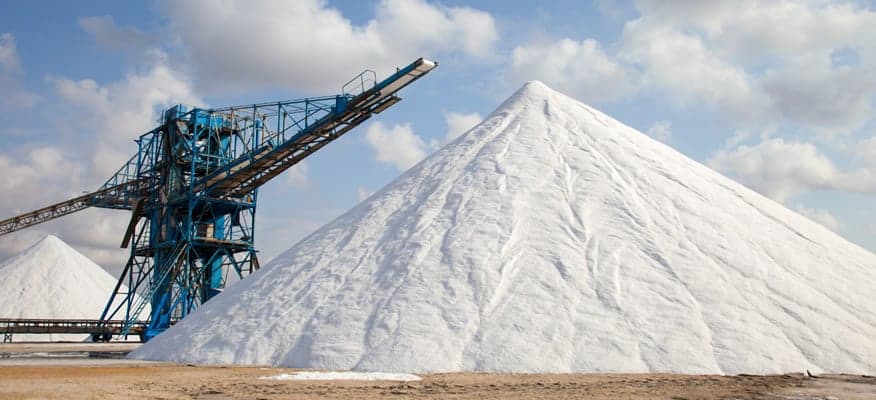Winter’s icy grip can be relentless, making the availability of bulk rock salt a lifeline for snow contractors. Yet, in recent years, the industry has witnessed sporadic rock salt shortages, leaving contractors and communities scrambling for solutions. In this comprehensive guide, we will delve into the dynamics of why these shortages occur, explore the possibility of another shortage, and provide invaluable strategies for snow contractors.
These strategies include conserving salt, developing a comprehensive contingency plan, exploring alternative de-icing materials, securing a trusted supplier, and fostering collaboration within the industry. With these strategies, snow contractors can not only survive but thrive during salt shortages, ensuring the safety and accessibility of roads, driveways, and walkways during even the harshest winter conditions.
Understanding the Why: Past Salt Shortages
Before diving into strategies for tackling rock salt shortages, it’s essential to grasp why they’ve occurred in the past. Several key factors have historically contributed to these shortages:
- Surging Demand: The demand for rock salt typically surges during severe winters, leading to the rapid depletion of stockpiles. Contractors and municipalities alike stock up, anticipating harsh conditions.
- Production Limitations: Rock salt production capacity has limitations, and interruptions in mining operations can disrupt the supply chain. Geological challenges, labor disputes, or equipment failures can all impact production.
- Extreme Weather Events: Unpredictable and severe weather events, such as polar vortexes and heavy snowstorms, can deplete salt reserves quickly. The greater the snowfall and ice, the more salt is required for effective de-icing.
- Logistical Hurdles: Transportation disruptions can play a significant role. Treacherous road conditions and limited trucking capacity during storms can impede salt deliveries, leading to delays and shortages.
The Ongoing Risk: Is Another Shortage Imminent?
As snow contractors gear up for the winter season, the question on many minds is whether another rock salt shortage is looming. While predicting the future is never a precise science, certain factors suggest that shortages remain a possibility:
- Erratic Weather Patterns: Unpredictable and extreme weather events can strain salt supplies, particularly in regions prone to severe winters. With climate change leading to more extreme weather events, this risk is growing.
- Rising Demand: A growing population and urbanization can lead to increased demand for salt, potentially outstripping supply capabilities. As communities expand, so does the need for effective snow and ice management.
- Supply Chain Disruptions: Disruptions in the supply chain, such as labor shortages or transportation challenges, can impact salt availability. The COVID-19 pandemic, for example, exposed vulnerabilities in supply chains.
- Increased Competition: Competition for salt supplies from various industries, including de-icing, water softening, and industrial uses, can further strain resources. Salt is a versatile mineral with diverse applications.
Given these factors, it’s prudent for snow contractors to prepare for potential shortages and implement strategies to mitigate their impact.
Strategies for Overcoming Rock Salt Shortages
1. Conservation: Make Every Grain Count
The efficient use of rock salt is paramount. Implementing precise spreading techniques, using calibrated equipment, and pretreating surfaces can significantly reduce salt consumption while maintaining effective de-icing results. Additionally, closely monitor salt usage throughout the winter season to identify trends and areas for further conservation.
2. Develop a Comprehensive Contingency Plan: Prepare for the Unforeseen
A well-crafted contingency plan is your best defense against rock salt shortages. This plan should encompass:
- Inventory Monitoring: Regularly assess your salt stockpile and establish reordering triggers. Keep a keen eye on your salt levels throughout the season.
- Alternative De-icers: Identify and stock alternative de-icing products like calcium chloride, magnesium chloride, or sand as backups. These materials can be invaluable during shortages.
- Effective Communication: Establish clear lines of communication with suppliers and local authorities to stay informed about salt availability and potential shortages. Early awareness can make a significant difference.
- Prioritization: Prioritize de-icing efforts based on essential routes and critical areas to optimize salt use. Focus on high-traffic and safety-critical areas.
3. Explore Rock Salt Alternatives: Diversify Your Arsenal
While rock salt is a staple, exploring alternative de-icing materials can provide flexibility during shortages. Consider these options:
- Calcium Chloride: Effective at lower temperatures than rock salt and less harmful to the environment. It also has the added benefit of reducing the refreeze cycle.
- Magnesium Chloride: Offers similar de-icing capabilities and is less corrosive to metal surfaces. It’s an excellent choice for sensitive environments.
- Potassium Acetate: Ideal for extremely cold conditions and less damaging to vegetation. It is often used at airports for its low-temperature effectiveness.
Evaluate these alternatives based on your specific needs and environmental considerations. Conduct trials during milder conditions to understand their performance.
4. Secure a Trusted Supplier: Forging a Dependable Partnership
Partnering with a reputable and experienced salt supplier, such as Snow & Ice Melt & Chemicals Unlimited, can significantly mitigate the impact of shortages. These suppliers often maintain diverse sources, well-managed inventories, and established logistics to ensure a continuous salt supply. Building a strong relationship with your supplier, clearly communicating your needs, and inquiring about their contingency plans for salt shortages are vital steps.
5. Collaborate Within the Industry: Strength in Unity
Recognize that you are not alone in facing salt shortages. Collaborate with other snow contractors in your region to share insights, resources, and strategies for managing shortages. Pooling resources and information can enhance your collective resilience during challenging times.
Preparedness is the Ultimate Weapon
As winter approaches, preparedness is your ultimate weapon against potential rock salt shortages. By comprehending the factors that contributed to past shortages, recognizing the ongoing risks, and implementing sound strategies for conservation, contingency planning, and diversification of resources, snow contractors can ensure their ability to keep roads, driveways, and walkways safe and clear, even in the face of the harshest winter conditions. Prepare today to conquer whatever winter brings tomorrow, and safeguard the well-being of your community. Together, we can overcome salt shortages and navigate winter’s challenges with confidence and resilience, ensuring the safety and accessibility of our roadways.
Have questions or need a quote? Our team can help!

